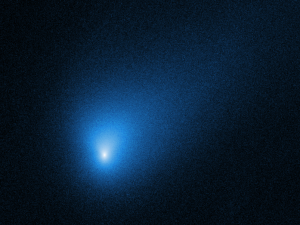Media
Transcript
Today we are going to be joined by guest Dr. Jian-Yang Li to discuss the chemistry of comet 2I/Borisov. Dr. Li is a Senior Scientist at the Planetary Science Institute who focuses his research on minor planets – the comets, asteroids, and objects in-between – that are scattered through our solar system. In recent months, Li’s research has turned to the interstellar comet Borisov.
Before we catch-up on that comet, let’s catch up on the news.
Our headlines start with a bang, or rather a burst. It was realized at the turn of the century that long-duration gamma ray bursts are tied to some massive star explosions. What exactly caused some stars to end their lives as normal supernovae and what caused some to have these associated GRBs and die as hypernovae have been a bit of a mystery, however, and researchers have looked for single-star solutions, such as stellar rotation, that could differ from one star to another.

New research from the International Center for Relativistic Astrophysics Network finds that sometimes even stars need a little help from a friend. Using computational models, they’ve found they can reproduce what is observed if they start from a massive carbon-oxygen burning star and a neutron star companion. When the massive star exhausts its fuel, it collapses into a new neutron star and jettisons a shell of material. The shell of material hitting the companion neutron star can actually be enough to collapse it into a black hole. Material streaming around this newly formed black hole or a souped-up now-larger neutron star can generate a massive magnetic field that in turn generates transitory jets we see as gamma ray bursts.
Let me put that another way – the star that goes supernova as it becomes a new neutron star is not the source of the GRB. Rather a companion star that takes friendly fire is the actual source, and the light curves we see are the combination of the normal supernova explosion and the sudden turn-on of a jet from the companion object’s new magnetic field that fades as the material is used up and pushed away. This new research is published in a trio of papers in The Astrophysical Journal.
This is the kind of science that changes our understanding of an event at a very fundamental level and shows that the solutions to problems large and even hypernova-sized sometimes require fantastical amounts of creativity.

From new computer models, we now turn to new observations. In early images using the new infrared pyramid wavefront sensor for adaptive optics (AO) correction, Keck Observatory showed what appeared to be planets orbiting the star PDS 70. It was initially unclear if this was real or an artifact in the images. Now it has been confirmed that this system is one that is the right combo of size, nearness, and brightness to allow us to distinguish the individual planets. These worlds are massive and still forming. According to team scientist Jason Wang, “Planet embryos form from a disk of dust and gas surrounding a newborn star. This circumstellar material accretes onto the protoplanet, creating a kind of smokescreen that makes it difficult to differentiate the dusty, gaseous disk from the developing planet in an image.” This smokescreen is both a boon and a curse – it points to where the planets are while screening them away, but careful imagery and data reduction allowed the background disk’s light to be removed to reveal the planets. This amazing work is just the start of what this new instrument will be able to do, and we look forward to seeing what will be learned as we image forming planet after forming planet throughout the nearby galaxy.

And that concludes our news for today, but that’s not all we have. In just a moment, you will hear a pre-recorded interview with Dr Jian-yang Li in which we discuss his observations of interstellar comet 2I/Borisov.
Learn More
Binary-Driven Hypernova Model Gains Observational Support
- ICRANet press release
- “Magnetic Fields and Afterglows of BdHNe: Inferences from GRB 130427A, GRB 160509A, GRB 160625B, GRB 180728A, and GRB 190114C,” J.A. Rueda et al., 2020 April 24, The Astrophysical Journal
Astronomers Confirm Existence Of Two Giant Newborn Planets In PDS 70 System
- W. M. Keck Observatory press release
- “Keck/NIRC2 L’-band Imaging of Jovian-Mass Accreting Protoplanets Around PDS 70,” Jason J. Wang et al., 2020 May 18, Astronomical Journal (Preprint on arxiv.org)
The dark and cold origins of interstellar visitor 2I/Borisov
- Nature Astronomy Behind the Paper blog post
- “The carbon monoxide-rich interstellar comet 2I/Borisov,” D. Bodewits et al., 2020 April 20, Nature Astronomy
Credits
Written and Hosted by Pamela Gay
Audio and Video Editing by Ally Pelphrey
Content Editing by Beth Johnson
Intro and Outro music by Kevin MacLeod, https://incompetech.com/music/


 We record most shows live, on Twitch. Follow us today to get alerts when we go live.
We record most shows live, on Twitch. Follow us today to get alerts when we go live.